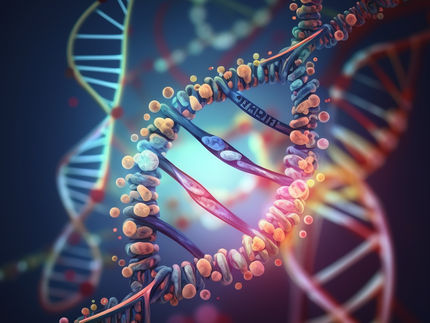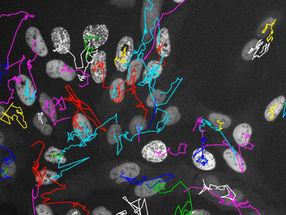New method studies living bacteria cells
Researchers at the U.S. Department of Energy's Argonne National Laboratory have found a new way to study individual living bacteria cells and analyze their chemistry.
In research published today in Science, the scientists used high-energy X-ray fluorescence measurements for mapping and chemical analyses of single free-floating, or planktonic, and surface-adhered, or biofilm, cells of Pseudomonas fluorescens. The results showed differences between the planktonic and adhered cells in morphology, elemental composition and sensitivity to hexavalent chromium, a heavy-metal contaminant and a known carcinogen. The biofilm cells were more tolerant of the contaminant, while it damaged or killed the planktonic cells.
In addition to determining the chemical differences between the cells, the work also pioneers a potentially revolutionary new technique for investigating microbiological systems in natural subsurface environments. This study advanced the development of high-energy X-ray microprobes and methods for using the microprobes to investigate single bacterial cells. The new capabilities set the stage for future studies defining mineral-metal-microbe interactions in contaminated environments.
"This technique also should be directly applicable to investigations of microbial processes in extreme subsurface environments and to studies of a variety of astrobiology topics, such as detection of past or present life in samples returned from Mars, or determinations of the origins of life," said lead author Ken Kemner of Argonne's Environmental Research Division.
No previously available techniques had the spatial resolution needed to analyze individual bacterial cells noninvasively and nondestructively. Recent developments at the Advanced Photon Source (APS) at Argonne enabled the production of X-ray beams small enough to probe single bacterial cells, which are typically one-hundredth the diameter of a human hair. The APS provides the nation's most brilliant X-rays for research.
In these experiments, scientists exposed both planktonic and biofilm cells to elevated concentrations of hexavalent chromium. The researchers then used X-ray fluorescence microscopy to measure the concentrations of elements in individual cells before and after exposure to the heavy metal. The results indicated that X-ray fluorescence analysis had distinguished living bacterial cells from dead cells for the first time. The analysis also showed that a bone-like mineral deposit had formed around the surface of the adhered cells. This deposit made the adhered cells much more tolerant than planktonic cells to elevated levels of the contaminant.
Next, the researchers used the energy tunability of the APS X-ray beamline for spectroscopy experiments on the bacterial systems. These experiments showed that the surface adherence of the biofilm cells promoted tolerance to the chromium and reduced its toxicity level.
Finally, when the cells made the transition from the planktonic state to the biofilm state, the scientists observed changes in the concentrations of many transition metals required for bacterial life. These results suggest that X-ray fluorescence analysis might be useful for determining whether a bacterial cell is living or dead.
"No other technique has been capable of determining the metabolic state of a single hydrated cell and the chemical speciation of metals on, in or near a bacterial cell," Kemner said. "The achievements of this study have the potential to revolutionize the way scientists investigate mineral-metal-microbe systems."
Most read news
Other news from the department science

Get the life science industry in your inbox
By submitting this form you agree that LUMITOS AG will send you the newsletter(s) selected above by email. Your data will not be passed on to third parties. Your data will be stored and processed in accordance with our data protection regulations. LUMITOS may contact you by email for the purpose of advertising or market and opinion surveys. You can revoke your consent at any time without giving reasons to LUMITOS AG, Ernst-Augustin-Str. 2, 12489 Berlin, Germany or by e-mail at revoke@lumitos.com with effect for the future. In addition, each email contains a link to unsubscribe from the corresponding newsletter.
Most read news
More news from our other portals
See the theme worlds for related content
Topic world Fluorescence microscopy
Fluorescence microscopy has revolutionized life sciences, biotechnology and pharmaceuticals. With its ability to visualize specific molecules and structures in cells and tissues through fluorescent markers, it offers unique insights at the molecular and cellular level. With its high sensitivity and resolution, fluorescence microscopy facilitates the understanding of complex biological processes and drives innovation in therapy and diagnostics.

Topic world Fluorescence microscopy
Fluorescence microscopy has revolutionized life sciences, biotechnology and pharmaceuticals. With its ability to visualize specific molecules and structures in cells and tissues through fluorescent markers, it offers unique insights at the molecular and cellular level. With its high sensitivity and resolution, fluorescence microscopy facilitates the understanding of complex biological processes and drives innovation in therapy and diagnostics.
Topic World Spectroscopy
Investigation with spectroscopy gives us unique insights into the composition and structure of materials. From UV-Vis spectroscopy to infrared and Raman spectroscopy to fluorescence and atomic absorption spectroscopy, spectroscopy offers us a wide range of analytical techniques to precisely characterize substances. Immerse yourself in the fascinating world of spectroscopy!

Topic World Spectroscopy
Investigation with spectroscopy gives us unique insights into the composition and structure of materials. From UV-Vis spectroscopy to infrared and Raman spectroscopy to fluorescence and atomic absorption spectroscopy, spectroscopy offers us a wide range of analytical techniques to precisely characterize substances. Immerse yourself in the fascinating world of spectroscopy!

























































